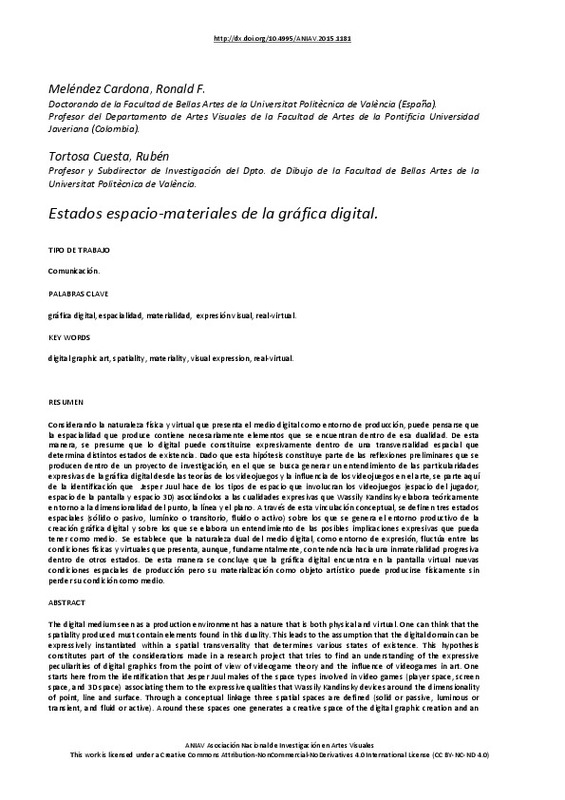JavaScript is disabled for your browser. Some features of this site may not work without it.
Buscar en RiuNet
Listar
Mi cuenta
Estadísticas
Ayuda RiuNet
Admin. UPV
Estados espacio-materiales de la gráfica digital
Mostrar el registro sencillo del ítem
Ficheros en el ítem
| dc.contributor.author | Meléndez Cardona, Ronald
|
es_ES |
| dc.contributor.author | Tortosa Cuesta, Rubén
|
es_ES |
| dc.date.accessioned | 2018-02-13T13:18:24Z | |
| dc.date.available | 2018-02-13T13:18:24Z | |
| dc.date.issued | 2015-11-26 | |
| dc.identifier.isbn | 9788490483411 | |
| dc.identifier.uri | http://hdl.handle.net/10251/97831 | |
| dc.description.abstract | [EN] The digital medium seen as a production environment has a nature that is both physical and virtual. One can think that the spatiality produced must contain elements found in this duality. This leads to the assumption that the digital domain can be expressively instantiated within a spatial transversality that determines various states of existence. This hypothesis constitutes part of the considerations made in a research project that tries to find an understanding of the expressive peculiarities of digital graphics from the point of view of videogame theory and the influence of videogames in art. One starts here from the identification that Jesper Juul makes of the space types involved in video games (player space, screen space, and 3D space) associating them to the expressive qualities that Wassily Kandinsky devices around the dimensionality of point, line and surface. Through a conceptual linkage three spatial spaces are defined (solid or passive, luminous or transient, and fluid or active). Around these spaces one generates a creative space of the digital graphic creation and an understanding of the possible expressive implications it may have as a medium. It is established that the dual nature of the digital medium, as an expression environment, fluctuates between the physical and virtual conditions it presents although fundamentally with a tendency towards a progressive immateriality within other states. Thus one concludes that the digital graphic creation finds in the virtual screen new spatial production conditions but its instantiation as an artistic object can be realized physically without losing its media character. | es_ES |
| dc.description.abstract | [ES] Considerando la naturaleza física y virtual que presenta el medio digital como entorno de producción, puede pensarse que la espacialidad que produce contiene necesariamente elementos que se encuentran dentro de esa dualidad. De esta manera, se presume que lo digital puede constituirse expresivamente dentro de una transversalidad espacial que determina distintos estados de existencia. Dado que esta hipótesis constituye parte de las reflexiones preliminares que se producen dentro de un proyecto de investigación, en el que se busca generar un entendimiento de las particularidades expresivas de la gráfica digital desde las teorías de los videojuegos y la influencia de los videojuegos en el arte, se parte aquí de la identificación que Jesper Juul hace de los tipos de espacio que involucran los videojuegos (espacio del jugador, espacio de la pantalla y espacio 3D) asociándolos a las cualidades expresivas que Wassily Kandinsky elabora teóricamente en torno a la dimensionalidad del punto, la línea y el plano. A través de esta vinculación conceptual, se definen tres estados espaciales (pasivo o sólido, transitorio o lumínico, activo o fluido) sobre los que se genera el entorno productivo de la creación gráfica digital y sobre los que se elabora un entendimiento de las posibles implicaciones expresivas que pueda tener como medio. Se establece que la naturaleza dual del medio digital, como entorno de expresión, fluctúa entre las condiciones físicas y virtuales que presenta, aunque, fundamentalmente, con tendencia hacia una inmaterialidad progresiva dentro de otros estados. De esta manera se concluye que la gráfica digital encuentra en la pantalla virtual nuevas condiciones espaciales de producción pero su materialización como objeto artístico puede producirse físicamente sin perder su condición como medio. | es_ES |
| dc.format.extent | 6 | es_ES |
| dc.language | Español | es_ES |
| dc.publisher | Editorial Universitat Politècnica de València | es_ES |
| dc.relation.ispartof | II CONGRESO INTERNACIONAL DE INVESTIGACIÓN EN ARTE VISUALES | es_ES |
| dc.rights | Reconocimiento - No comercial - Sin obra derivada (by-nc-nd) | es_ES |
| dc.subject | Gráfica digital | es_ES |
| dc.subject | Espacialidad | es_ES |
| dc.subject | Materialidad | es_ES |
| dc.subject | Expresión visual | es_ES |
| dc.subject | Real-virtual | es_ES |
| dc.subject.classification | DIBUJO | es_ES |
| dc.title | Estados espacio-materiales de la gráfica digital | es_ES |
| dc.type | Capítulo de libro | es_ES |
| dc.type | Comunicación en congreso | es_ES |
| dc.identifier.doi | 10.4995/ANIAV.2015.1181 | |
| dc.rights.accessRights | Abierto | es_ES |
| dc.contributor.affiliation | Universitat Politècnica de València. Departamento de Dibujo - Departament de Dibuix | es_ES |
| dc.contributor.affiliation | Universitat Politècnica de València. Facultad de Bellas Artes - Facultat de Belles Arts | es_ES |
| dc.description.bibliographicCitation | Meléndez Cardona, R.; Tortosa Cuesta, R. (2015). Estados espacio-materiales de la gráfica digital. En II CONGRESO INTERNACIONAL DE INVESTIGACIÓN EN ARTE VISUALES. Editorial Universitat Politècnica de València. 497-502. https://doi.org/10.4995/ANIAV.2015.1181 | es_ES |
| dc.description.accrualMethod | OCS | es_ES |
| dc.relation.conferencename | II Congreso Internacional de Investigación en Artes Visuales. |< real | virtual >| ANIAV2015 | es_ES |
| dc.relation.conferencedate | July 09-10,2015 | es_ES |
| dc.relation.conferenceplace | Valencia, Spain | es_ES |
| dc.relation.publisherversion | http://ocs.editorial.upv.es/index.php/ANIAV/ANIAV2015/paper/view/1181 | es_ES |
| dc.description.upvformatpinicio | 497 | es_ES |
| dc.description.upvformatpfin | 502 | es_ES |
| dc.type.version | info:eu-repo/semantics/publishedVersion | es_ES |
| dc.relation.pasarela | OCS\1181 | es_ES |








